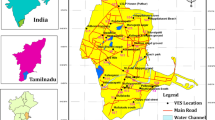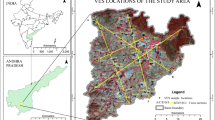Abstract
Demarcation of aquifer boundaries and hydro-geologic characterization can help in proper management and conservation of groundwater resources of a coastal region. The objective of the present study is to identify and delineate the groundwater-bearing zones and protection of freshwater aquifers from saltwater ingress in the northern parts of Sindhudurg district, western Maharashtra, India. A total of 86 vertical electrical soundings (VES) were carried out by Schlumberger electrode arrangement to infer the sub-surface lithology around Kankavali, Vijaydurg, and Malvan. The Dar-Zarrouk parameters were computed to generate the spatial variation maps of transverse resistance (T), longitudinal conductance (S), transverse resistivity (ρt), and longitudinal resistivity (ρl), to decipher the resistivity contrast of fresh water and salt water-bearing formations. The results demonstrate that these parameters provide a better resolution in delineating the seawater intrusion in coastal aquifers. The overburden aquifer protective capacity computed from the longitudinal conductance suggests that 59% of the area has poor aquifer protection, while 23% has weak, 11% has moderate and 7% falls in good protective capacity rating. This parameter reveals the infiltration of contaminants and the health of the aquifer. The electrical anisotropy (λ) value ranges from 0.9 to 5.1, suggesting an increase from SW to NE and also from SE to NW. The fracture porosity (φf) ranges from 10−6 to 0.65, which corroborates with the high and low λ values, reflecting that fracturing is due to anisotropy and significant reserves of groundwater could be exploited in this coastal region.








Similar content being viewed by others
References
Ali Kaya M, Özürlan G, Balkaya Ç (2015) Geoelectrical investigation of seawater intrusion in the coastal urban area of Çanakkale, NW Turkey. Environ Earth Sci 73:1151–1160
Ayolabi EA, Folorunso AF, Oloruntola MO (2010) Constraining causes of structural failure using electrical Resistivty tomography (ERT): a case study of Lagos, southwestern, Nigeria. Mineral Wealth 156:7–18
Batayneh AT (2013) The estimation and significance of Dar-Zarrouk parameters in the exploration of quality affecting the Gulf of Aqaba coastal aquifer systems. J Coast Conserv 17:623–635. https://doi.org/10.1007/s11852-013-0261-4
Bhattacharya PK, Patra HP (1968) Direct Current Electric Sounding. (Methods in Geochemistry and Geophysics, 9) Elsevier Publishing Co., Amsterdam, ix + 135, 47
Bobachev A (2003) Resistivity sounding interpretation. IPI2WIN:version 3.0.1, a 7.01.03 Moscow State University
Central Groundwater Board (CGWB) (2014) Groundwater information, Sindhudurg district, Maharashtra. Technical Report 1835/DB/2014
Deolankar SB (1980) The Deccan basalt of Maharashtra, India- their potential as aquifers. Ground Water 18(5):434–437
Deshpande GG (1998) Geology of Maharashtra. Geological Society of India, Bangalore, 223p
Flathe H (1955) Possibilities and limitations in applying geoelectrical methods to hydrogeological problems in the coastal area of Northwest Germany. Geophys Prospect 3:95–110
Gupta G, Maiti S, Erram VC (2014) Analysis of electrical resistivity data in resolving the saline and fresh water aquifers in west coast Maharashtra, India. J Geol Soc India 84:555–568
Habberjam GM (1972) The effect of anisotropy on square array resistivity measurements. Geophys Prospect 20:249–266
Henriet JP (1976) Direct application of the Dar-Zarrouk parameters in ground water surveys. Geophys Prospect 24:344–353
Isife FA, Obasi RA (2012) Electrical anisotropy of crystalline basement/ sediment rock around Ifon, South-Western Nigeria: implications in geologic mapping and groundwater investigation. ARPN J Eng Appl Sci 7:634–640
Keller GV (1982) Electrical properties of rocks and minerals. In: Carmichael RS (ed) Hand book of physical properties of rocks. CRC Press, pp 217–293
Lane JW Jr, Haeni FP, Watson WM (1995) Use of a square array direct current resistivity method to detect fractures in crystalline bedrock in New Hampshire. Ground Water 33(3):476–485
Lee S, Kim K, Ko I, Lee S, Hwang H (2002) Geochemical and geophysical monitoring of saline water intrusion in Korean paddy fields. Environ Geochem Health 24:277–291
Loke MH (2000) Electrical imaging surveys for environmental and engineering studies. A practical guide to 2-D and 3-D surveys
Maiti S, Erram VC, Gupta G, Tiwari RK, Kulkarni UD, Sangpal RR (2013) Assessment of groundwater quality: a fusion of geochemical and geophysical information via Bayesian neural networks. Environ Monit Assess 185:3445–3465
Maillet R (1947) The fundamental equation of electrical prospecting. Geophysics 12:529–556
Maillet GM (2005) Recent and current sedimentary relationships between a river and its delta in micro tidal area: example from Rhône River mouth. Unpubl. Ph. D. Thesis, University of Provence, Aix-Marseille 1, 301
Mondal NC, Singh VP, Ahmed S (2013) Delineating shallow saline groundwater zones from southern India using geophysical indicators. Environ Monit Assess 185:4869–4886
Niwas S, Singhal DC (1981) Estimation of aquifer transmissivity from Dar-Zarrouk parameters in porous media. J Hydrol 50:393–399
Oladapo MI, Mohammed MZ, Adeoye OO, Adetola BA (2004) Geo-electrical investigation of Ondo state housing Coperation estate, Ijapo, Akure, South Western Nigeria. Jour Mining Geol 40(1):41–48
Orellana E, Mooney HM (1966) Master Tables and curves for Vertical Electrical Sounding over layered structures Intercientia Madrid Spain. 193
Salem HS (1999) Determination of fluid transmissivity and electric transverse resistance for shallow aquifers and deep reservoirs from surface and well-log electric measurements. Hydrol Earth Syst Sci 3(3):421–427
Singh KP (2005) Nonlinear estimation of aquifer parameters from surficial resistivity measurements. Hydrol Earth Syst Sci Dis 2:917–938
Suneetha N, Gupta G (2018) Assessment of groundwater quality for irrigational use: a case study from the coastal tracts of Sindhudurg district, Maharashtra. Indian J Mar Sci 47(10):2013–2020
Suneetha N, Gupta G, Tahama K, Erram VC (2020) Two-dimensional modelling of electrical resistivity imaging data for assessment of saline water ingress in coastal aquifers of Sindhudurg district, Maharashtra, India. Model Earth Syst Environ 6:731–742. https://doi.org/10.1007/s40808-020-00725-w
Watson KA, Barker RD (1999) Differentiating anisotropy and lateral effects using azimuthal resistivity offset Wenner soundings. Geophysics 64(3):1–7
Webster R, Oliver MA (2001) Geostatics for environmental scientists. Wiley, Chichester
WHO (2011) Guidelines to drinking water quality. World health organization 4th Edn Geneva Switzerland
Zohdy AR (1989) A new method for automatic interpretation of Schlumberger and Wenner sounding curves. Geophysics 54:245–253
Acknowledgments
The authors are thankful to the Director, IIG, for the kind permission to publish this paper. They are also grateful to Shri B.D. Kadam, Dr. V.C. Erram, and Dr. M. Laxminarayana for their keen interest in data acquisition. The first author (SN) is obliged to IIG, Panvel for the financial support in the form of a research fellowship. The authors are highly indebted to Shri B.I. Panchal for drafting the figures.
Author information
Authors and Affiliations
Corresponding author
Additional information
Publisher’s note
Springer Nature remains neutral with regard to jurisdictional claims in published maps and institutional affiliations.
Rights and permissions
About this article
Cite this article
Naidu, S., Gupta, G., Shailaja, G. et al. Spatial behavior of the Dar-Zarrouk parameters for exploration and differentiation of water bodies aquifers in parts of Konkan coast of Maharashtra, India. J Coast Conserv 25, 11 (2021). https://doi.org/10.1007/s11852-021-00807-6
Received:
Revised:
Accepted:
Published:
DOI: https://doi.org/10.1007/s11852-021-00807-6




